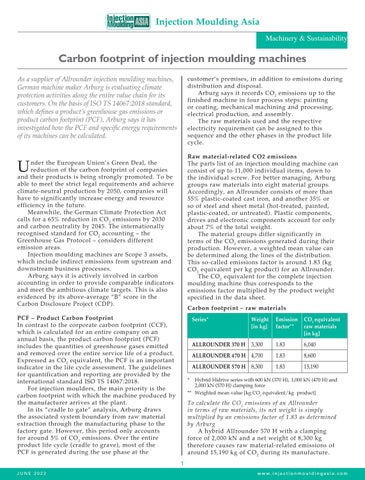Injection Moulding Asia Machinery & Sustainability
Carbon footprint of injection moulding machines As a supplier of Allrounder injection moulding machines, German machine maker Arburg is evaluating climate protection activities along the entire value chain for its customers. On the basis of ISO TS 14067:2018 standard, which defines a product’s greenhouse gas emissions or product carbon footprint (PCF), Arburg says it has investigated how the PCF and specific energy requirements of its machines can be calculated.
customer’s premises, in addition to emissions during distribution and disposal. Arburg says it records CO 2 emissions up to the finished machine in four process steps: painting or coating, mechanical machining and processing, electrical production, and assembly. The raw materials used and the respective electricity requirement can be assigned to this sequence and the other phases in the product life cycle.
U
Raw material-related CO2 emissions The parts list of an injection moulding machine can consist of up to 11,000 individual items, down to the individual screw. For better managing, Arburg groups raw materials into eight material groups. Accordingly, an Allrounder consists of more than 55% plastic-coated cast iron, and another 35% or so of steel and sheet metal (hot-treated, painted, plastic-coated, or untreated). Plastic components, drives and electronic components account for only about 7% of the total weight. The material groups differ significantly in terms of the CO 2 emissions generated during their production. However, a weighted mean value can be determined along the lines of the distribution. This so-called emissions factor is around 1.83 (kg CO 2 equivalent per kg product) for an Allrounder. The CO 2 equivalent for the complete injection moulding machine thus corresponds to the emissions factor multiplied by the product weight specified in the data sheet.
nder the European Union’s Green Deal, the reduction of the carbon footprint of companies and their products is being strongly promoted. To be able to meet the strict legal requirements and achieve climate-neutral production by 2050, companies will have to significantly increase energy and resource efficiency in the future. Meanwhile, the German Climate Protection Act calls for a 65% reduction in CO 2 emissions by 2030 and carbon neutrality by 2045. The internationally recognised standard for CO 2 accounting – the Greenhouse Gas Protocol – considers different emission areas. Injection moulding machines are Scope 3 assets, which include indirect emissions from upstream and downstream business processes. Arburg says it is actively involved in carbon accounting in order to provide comparable indicators and meet the ambitious climate targets. This is also evidenced by its above-average “B” score in the Carbon Disclosure Project (CDP).
Carbon footprint – raw materials
PCF – Product Carbon Footprint In contrast to the corporate carbon footprint (CCF), which is calculated for an entire company on an annual basis, the product carbon footprint (PCF) includes the quantities of greenhouse gases emitted and removed over the entire service life of a product. Expressed as CO 2 equivalent, the PCF is an important indicator in the life cycle assessment. The guidelines for quantification and reporting are provided by the international standard ISO TS 14067:2018. For injection moulders, the main priority is the carbon footprint with which the machine produced by the manufacturer arrives at the plant. In its “cradle to gate” analysis, Arburg draws the associated system boundary from raw material extraction through the manufacturing phase to the factory gate. However, this period only accounts for around 5% of CO 2 emissions. Over the entire product life cycle (cradle to grave), most of the PCF is generated during the use phase at the
Series* Weight Emission [in kg] factor** ALLROUNDER 370 H
CO2 equivalent raw materials [in kg]
3,300
1.83
6,040
ALLROUNDER 470 H 4,700
1.83
8,600
ALLROUNDER 570 H 8,300
1.83
15,190
*
Hybrid Hidrive series with 600 kN (370 H), 1,000 kN (470 H) and 2,000 kN (570 H) clamping force ** Weighted mean value [kg CO2 equivalent/kg product]
To calculate the CO 2 emissions of an Allrounder in terms of raw materials, its net weight is simply multiplied by an emissions factor of 1.83 as determined by Arburg A hybrid Allrounder 570 H with a clamping force of 2,000 kN and a net weight of 8,300 kg therefore causes raw material-related emissions of around 15,190 kg of CO 2 during its manufacture. 1
JUNE 2022
www.injectionmouldingasia.com
